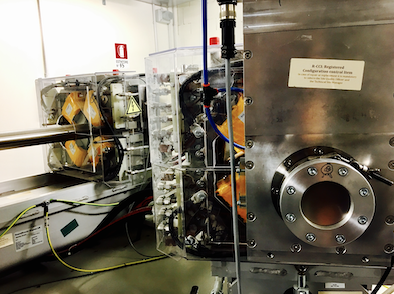Speaker
Description
The radiosensitivity of biological systems is strongly affected by the system oxygenation. On the molecular level, this effect is considered to be related to the indirect damage and in particular to the effect of the OH• radicals. Several theories have been developed and among them the so called oxygen fixation hypothesis is so far the most accepted one. Recent studies open up another possible pathway which can also take part in the oxygen induced radio sensitivity. In oxygenated media, in particular, solvated electrons, eaq−•, and hydrogen atoms, H•, are generated in large quantities and react with dissolved molecular oxygen to form the superoxide anion, O2•−, and its protonated form HO2•. Both these species have been identified as possibly responsible of the oxygen driven radiosensitization effect. It has been observed that densely ionizing radiation can mitigate hypoxia induced radioresistance, motivating a growing interest in ion radiation therapy for the treatment of hypoxic tumors. On the microscopic scale, this effect can be explained as a track density effect. Monte Carlo track structure codes are particularly suitable for studying the microscopic processes involved in the radiation damage, including their spatiotemporal evolution. However, the majority of these codes are limited to pure water targets and in few cases in oxygenated water targets. Additionally, all these codes are subject to large uncertainties due to the very limited amount of experimental data for benchmarking, especially in oxygenated media. For low LET radiation an oxygen depletion rate of 0.33 μM/Gy has been measured in PBS. Additionally, results of oxygen depletion in cell culture medium show an increased oxygen consumption (of a factor around 4/3) due to subsequent reaction with carbon centered radicals. First experiments with keV X-rays and clinical MeV photons from this group confirm these values. To our best knowledge however, no experimental data for protons and ion radiation in oxygenated targets is available.
These measurements result particularly relevant for the basic understanding of the chemical processes involved in the oxygen induced radio sensitivity on biological media, and allow to benchmark the chemical stage predictions of Monte Carlo track structure codes. The latter predictions are an essential step for building a mechanistic understanding basis for unraveling different processes, including the peculiar depletion features at high dose rate supposed as the driving force in the FLASH effect.
Within this context an experimental campaign to perform a series of oxygen depletion measurements in conventional dose rates for different proton beam energies in different oxygenated media has been approved at the Trento proton beamline and is planned for the next months.
The experimental approach and preliminary results will be here presented.

